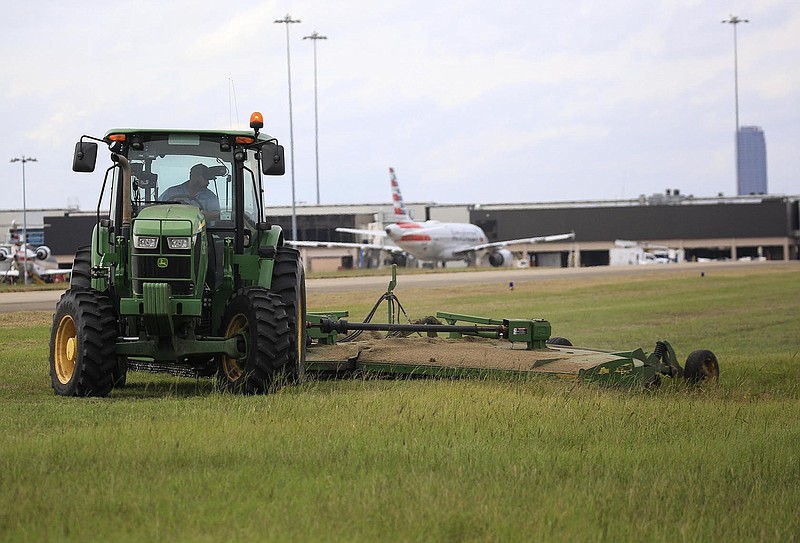The state's largest airport also has one of the largest lawns to mow in Arkansas -- 800 acres of grass on the airfield alone, the equivalent of more than 600 football fields that at the peak of the summer growing season needs to be mowed every week.
With the growing season winding down, executives at Bill and Hillary Clinton National Airport/Adams Field, were looking ahead to next year when they sought permission to order three zero-turn mowers to replace three acquired in 2012.
Assuming the Little Rock Municipal Airport Commission approves the request, the mowers won't arrive until next Spring, but it will be in time for another growing season.
A staff of 21 employees oversee maintenance on the airfield. Many of the employees are electricians who are charged with maintaining the elaborate lighting for three runways and several taxiways, consisting of thousands of lights as well as small in-ground transformers for each one.
They also are the ones who will break out the plows and other equipment when it snows to keep the runways clear and allow planes to land and take off. They must make repairs to fences and other items often identified by the airport operations staff, who inspect the airfield twice daily.
The airfield staff is led by airfield manager Terry Jaskowiak and airfield supervisor Jason Gray, who say the grass is kept in check for a variety of reasons. Above all, Federal Aviation Administration regulations require it, Jaskowiak said.
And not for appearances' sake.
The grass must be mowed regularly to keep it from blocking the runway and taxiway lights. The grass also mustn't grow tall enough to obscure any of the runway and taxiway guidance signs pilots unfamiliar with the airport would need to help navigate the matrix of taxiways between the runways and the terminal.
Sensitive landing navigation equipment can be affected if the grass grows too tall, according to Jaskowiak.
"Tall grass can affect the beams" used to transmit data between the aircraft and the ground, he said.
Another reason is mitigation to limit the potential for birds striking aircraft, which happens occasionally, especially given the airport's proximity to the Arkansas River.
It works this way: long grass can seed, which in turn is a food source that attracts rodents, mice and other small mammals. Those then attract coyotes and raptors, particularly hawks and falcons.
Even the size of the airport's three runways pale in comparison to the airport greenway.
The two main runways are each more than 8,200 feet long. The general aviation runway is more than 6,200 feet long. All three are 150 feet wide. Together, their mass equals about 78 acres, less than 10% of the grass acreage.
In addition to the 800 acres inside the fence, there is the 11 miles of grass around the perimeter fence itself, according to Gray. Further, his crew also maintains the landscaped areas outside the fence as well as the 30 to 40 lots the airport has purchased outside the airport proper.
The new zero-turn models the airport is acquiring cost $13,493.22 each, which totals to $40,479.66. If approved, they will be acquired under a cooperative purchasing agreement. The airport also will buy three cabs that can be fitted over the zero-turn mowers, a first for those models, which have been open-air. All seven tractors have enclosed cabs.
The zero-turn mower cabs -- each of which will cost about $10,000 each -- include cooling systems to regulate the temperature inside the cab during the hottest months of the year.
Gray said the cab also will protect his workers from inhaling the dry grass that the zero-turn mowers can kick up. The airport also hopes to eventually equip them with equipment that will allow them to communicate with air-traffic control.
The staff schedule allows people to be available six days a week. Every day is needed to mow when the growing season peaks during the hottest months of the summer, according to Randy Ellison, the airport's facilities director.
"In the peak time of year, you start work at the beginning of the week and by the end of the week, you're ready to go back and start again," he said.
"It's a non-stop event," Jaskowiak added. "It's hard to keep up with everything. It's all hands on deck. We keep those mowers running in peak season. We keep real good control of it in spring and fall."
Rain can put them behind because they are unable to mow unless the grassy areas are dry, particularly in the safety areas, which are located at each end of all three runways as well as along their sides.
The so-called RSAs are specially designed to reduce the risk of damage to aircraft should they undershoot, overshoot or depart the runway. If those areas are wet, the mowers could leave ruts, which could result in the loss of directional control if an aircraft landing gear rolled into one. Jaskowiak said.
The zero-turn mowers also come in handy for the close-in mowing that must be done around the taxiway and runway lights. A mower has been known to hit one a time or two, but they are mounted on frangible couplings that are designed to break away on impact by aircraft.
"Typically, all we have to do is replace a coupling," Gray said.
